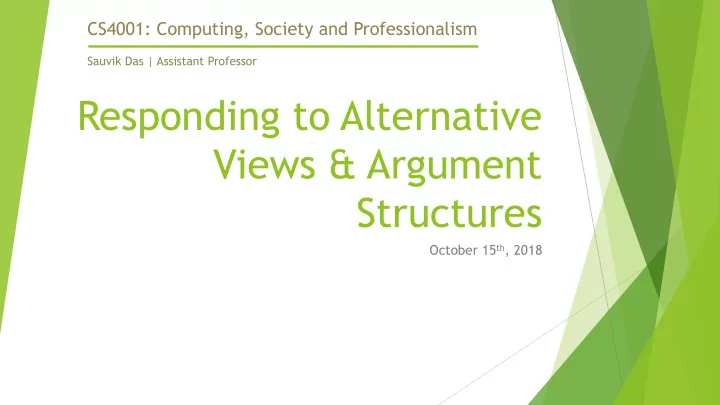

CS4001: Computing, Society and Professionalism Sauvik Das | Assistant Professor Responding to Alternative Views & Argument Structures October 15 th , 2018
Rhetorical tools Logos: appeals to logic u Ethos: appeals to authority u Pathos: appeals to emotion u Kairos: timeliness u Pick tools that are most convincing to your target audience u
Class Discussion: How to improve ethos in your writing? Be knowledgeable u Be fair u Build a bridge to your audience u u Connect to shared values and assumptions Demonstrate professionalism u u Appropriate style, careful editing, adherence to genre expectations
Class Discussion: How to improve pathos in your writing? Use concrete language u Use specific examples and illustrations u Use narratives u Choose words, metaphors and analogies with appropriate connotations u Use images u
Using pathos Pathos is legitimate to the extent it deepens understanding of the issue u u What are examples? u What are counter-examples?
Ethosappeals to: Intelligence Virtue Morals Perception of trustworthiness Pathosappeals to: Emotions Biases and prejudices Senses Motivations Logos utilizes: Evidence Testimony Statistics and Data Universal truths
Kairos Timeliness / the right moment u What’s an example? u
Class Discussion: Prius Ad
Group Activity Now that you know the topics for your term paper, with one other classmate, u discuss appeals to ethos, pathos, logos and kairos that you might employ in your essay. Then swap.
Customizing to audience enhances rhetorical strength Who is your audience? u How much does your audience know or care about your issue? u What is your audience’s current attitude towards the issue? u What will be your audience’s likely objections? u What values, beliefs, or assumptions about the world do you and your u audience share?
Audience-based reasons Very common problem in research: failure to understand audience. u Often, you will have multiple audiences u
Adversarial vs Dialogic argument In adversarial, writer presents other side as flawed u u Typical argument you see in politics Dialogic is more neutral – “truth seeking” u u Enlists reader as a partner in truth seeking u Encourage sympathy for more than one point of view
Audience-based argument selection Determine audience’s resistance to your views u If the issue is whether or not to build a new baseball stadium, there might be u the following different type of audiences: u No interest in sports u Opposition to public funding of sports u Opposition to raising taxes u Opposition to retractable roof Hard to address all of these audiences at once. u
Classical argument Appeals to neutral or undecided audience u Summarize opposing views fairly u Principle of charity u u Avoid distorting or oversimplifying opposing views u Don’t strawman Once you summarize opposing views, either rebut or concede u
Rebutting opposing views Claim: We shouldn’t elect Joe as chairperson u Reason: Because he is bossy u Grounds: Evidence that Joe is bossy u Warrant: Bossy people make bad chairpersons u
Rebuttal strategies Can rebut stated reason and grounds u u Joe isn’t really bossy Can rebut warrant and backing u u Bossy people can make great chairpersons
Rebutting evidence Deny the accuracy of the data u Cite counterexamples or counter-testimony u Doubt the representativeness or sufficiency of the examples u Doubt the relevance or recency of examples, statistics, and testimony u Call into question the credibility of the authority u u NOT the same as an ad hominem attack u attack credibility on this issue; not their general character Question the accuracy or context of quotations u Question how statistical data were produced or interpreted u
Conceding opposing views Concede opposing view, but introduce a new warrant (new value system) u Claim: We should legalize drugs. u Opposing view: We shouldn’t legalize drugs because it will increase the u number of addicts. Concession: Yes, legalizing drugs will probably increase the number of u addicts. But, will also help eliminate black market & associated crime
Delayed-thesis argument Audience: Skeptical with limited knowledge of issue u Complicates the issue (instead of simplifying). Heights reader interest and u sympathy. Intro u Dialogic discussion u u Explores issue from multiple points of view Delayed thesis and support u Conclusion u
Rogerian argument Audience: Interested and resistant u Show that writer and resistant audience share many values u Wait until the end to express a view that is usually a compromise between the u writer’s original view and the resistant audience Especially effective in emotionally laden issues u Must understand audience POV u Stresses self-examination, clarification and accommodation rather than u refutation
Rogerian argument structure Intro u Summary of audience’s views u Common ground u Contribution of new points to the negotiation u Conclusion u
Group Activity Pick an argument structure for your term paper classical vs delayed-thesis or u Rogerian. Explain your paper and why you chose that argument structure to a classmate u you don’t already know. Then swap. Discuss!
Recommend
More recommend